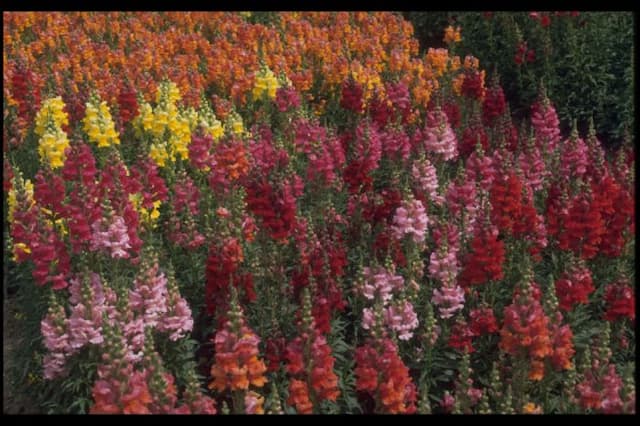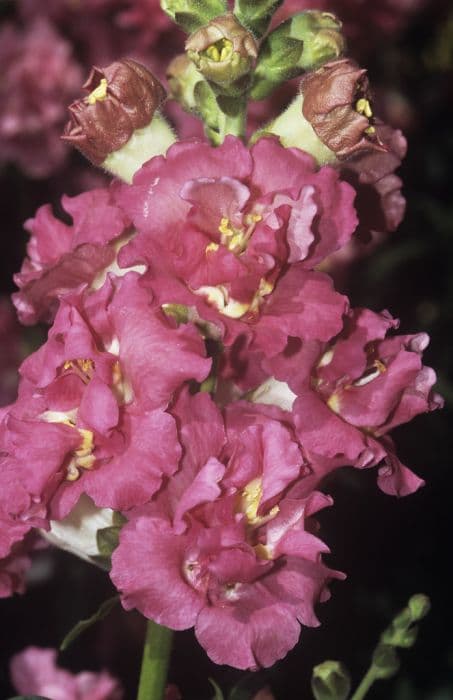Beardtongue Penstemon 'White Bedder'

ABOUT
The Penstemon 'White Bedder', often referred to as beardtongue, is a charming perennial known for its attractive tubular white flowers. These blossoms have a generous open-throated appearance that is poised elegantly atop upright stems. The flowers are arranged in panicles, forming dense clusters that create a visually striking display. Each individual flower of the beardtongue 'White Bedder' consists of a tube that flares out into five lobes, with the lower lobe being slightly larger and sometimes adorned with subtle markings or stripes, which guide pollinators to the nectar within. The pure white of the flowers provides a luminous contrast against the foliage. The leaves of the White Bedder beardtongue are typically narrow, lance-shaped, and can be quite long. They are a rich green in color and have a slightly glossy surface, which provides a lush frame that highlights the bright whiteness of the blooms. The plant presents a bushy habit with a robust disposition, showcasing a blend of harmonious greens and crisp whites in an aesthetically pleasing arrangement. Despite its delicate appearance, 'White Bedder' is a hardy plant that adds grace and a touch of elegance to any garden setting.
About this plant
 Names
NamesFamily
Plantaginaceae
Synonyms
Beard Tongue, Beardtongue
Common names
Penstemon 'White Bedder'
 Toxicity
ToxicityTo humans
Penstemon, commonly known as beardtongue, is generally considered non-toxic to humans. Therefore, there is no well-documented toxicity or symptoms associated with the ingestion of any part of this plant for humans.
To pets
Beardtongue is not typically listed as a toxic plant to pets either. It is considered non-toxic to dogs and cats, so no adverse effects are generally expected if pets ingest this plant. However, all animals are different and individual allergic reactions or sensitivities can occur. If you suspect your pet has ingested an unusual amount or is showing signs of illness, it is recommended to consult a veterinarian.
 Characteristics
CharacteristicsLife cycle
Perennials
Foliage type
Deciduous
Color of leaves
Green
Flower color
White
Height
2 feet (0.61 meters)
Spread
2 feet (0.61 meters)
Plant type
Herb
Hardiness zones
8
Native area
North America
Benefits
 General Benefits
General Benefits- Attracts pollinators: Penstemon White Bedder is known for attracting bees, butterflies, and other beneficial insects to the garden, which can help pollinate plants and improve biodiversity.
- Drought-tolerant: Once established, it is relatively drought-resistant, making it suitable for xeriscaping or low-water garden areas.
- Easy to grow: It is not overly demanding regarding soil type or care, making it a good choice for novice gardeners.
- Long blooming period: It produces flowers from late spring to early fall, providing a long season of visual interest.
- Deer-resistant: It is not a preferred plant for deer to browse, thus it’s less likely to be damaged in areas with deer populations.
- Colorful addition to borders: With its white flowers, it adds brightness and contrast to perennial borders or flowerbeds.
- Rapid growth: Penstemon White Bedder can grow quickly, filling in garden spaces and providing a lush appearance in a relatively short time.
- Versatility: It can be used in a variety of garden designs, including cottage gardens, rock gardens, or wildflower meadows.
- Cut flowers: The stems of Penstemon White Bedder can be cut and used in floral arrangements, adding beauty indoors as well as outdoors.
 Medical Properties
Medical PropertiesThis plant is not used for medical purposes.
 Air-purifying Qualities
Air-purifying QualitiesThis plant is not specifically known for air purifying qualities.
 Other Uses
Other Uses- Artistic Inspiration: Penstemon White Bedder, with its striking white blooms, can serve as an excellent subject for botanical drawing, painting, or photography, providing aesthetic value and a subject for artists.
- Educational Uses: The plant can be used in educational gardens or horticulture programs to teach about pollinator-friendly plants and the importance of native flora in garden ecosystems.
- Culinary Garnish: While not commonly consumed, the flowers can be used as a decorative, non-toxic garnish for salads and desserts to add visual appeal to dishes.
- Dye Production: The blooms and leaves of Penstemon White Bedder may be used to create natural dyes for fabrics or papers, resulting in subtle colors.
- Wedding Decor: The pure white flowers can be incorporated into wedding décor, for instance in table centerpieces or bridal bouquets, lending a natural and elegant touch to the event.
- Landscape Design: The plant is used to provide aesthetic contrast in gardens, with its white flowers standing out against green foliage and other colored plants.
- Fragrance Source: Although Penstemon White Bedder is not known for a strong scent, its flowers can contribute to a mild fragrance profile for potpourris or natural sachets.
- Faunal Habitat: They can be used in gardens designed to create habitats for beneficial insects like bees, butterflies, and other pollinators.
- Companion Planting: Penstemon White Bedder can be planted alongside other perennials to create a succession of blooming, ensuring there are flowers in the garden throughout the growing season.
- Craft Material: Its sturdy stems and attractive flowers can be used in the creation of floral crafts, such as wreaths, dried flower arrangements, or decorative dried bouquets.
Interesting Facts
 Feng Shui
Feng ShuiThe plant_name is not used in Feng Shui practice.
 Zodiac Sign Compitability
Zodiac Sign CompitabilityThe plant_name is not used in astrology practice.
 Plant Symbolism
Plant Symbolism- Hardiness: Penstemon, also known as Beardtongue, often symbolizes hardiness due to its ability to withstand diverse and challenging growing conditions.
- Versatility: This plant can adapt to a variety of soil types and climates, representing adaptability and versatility.
- Diversity: With numerous species and hybrids, Penstemon celebrates diversity in nature and can symbolize the beauty of variety in life.
- Communication: The tubular shape of its flowers has been thought to resemble open mouths, hence the name Beardtongue, potentially symbolizing openness to communication and expression.
- Attraction: Beardtongue's vibrant flowers are known to attract pollinators like bees and hummingbirds, symbolizing allure and the ability to attract positive attention.
 Water
WaterBeardtongue, commonly known as 'White Bedder', should be watered deeply and allowed to dry out slightly between waterings. This plant prefers consistent moisture but does not like to be waterlogged. Watering once a week with approximately one to two gallons, depending on weather conditions and soil type, is typically sufficient. During hot, dry periods, additional watering may be required to maintain soil moisture. Ensure the water reaches the root zone by watering at the base of the plant to avoid wetting the foliage, which can lead to fungal diseases.
 Light
LightBeardtongue thrives in full sun to partial shade conditions. The ideal spot for 'White Bedder' would be where it can receive at least six hours of sunlight each day. It can tolerate some shade, especially in hotter climates, but flowering is best with ample sunlight.
 Temperature
TemperatureBeardtongue 'White Bedder' prefers temperate conditions and does well in a range of temperatures, from approximately 40 to 85 degrees Fahrenheit. It can survive short periods of colder temperatures down to about 20 degrees Fahrenheit but may require protection from frost. The ideal temperature for promoting growth and flowering is between 60 and 70 degrees Fahrenheit.
 Pruning
PruningPruning beardtongue is important to maintain plant vigor and promote dense, bushy growth. Prune in late winter or early spring, before new growth starts. Deadheading spent flowers during the growing season can encourage more blooms. Cut back the plants by up to one third after flowering is finished to rejuvenate the foliage and shape the plant.
 Cleaning
CleaningAs needed
 Soil
SoilBeardtongue thrives in well-draining soil, ideally a mix containing loam, sand, and some organic matter. The best soil pH for Beardtongue is slightly acidic to neutral, ranging from 6.0 to 7.0.
 Repotting
RepottingBeardtongue does not often require repotting and can generally be expected to be repotted every 2 to 3 years to refresh the soil or if it outgrows its current pot.
 Humidity & Misting
Humidity & MistingBeardtongue prefers moderate humidity levels; however, it is adaptable and does not require specific humidity adjustments when grown in typical home environments.
 Suitable locations
Suitable locationsIndoor
Place in bright, indirect light and ensure good air circulation.
Outdoor
Plant in full sun to partial shade with well-draining soil.
Hardiness zone
4-9 USDA
 Life cycle
Life cycleThe life of a Penstemon 'White Bedder', commonly known as Beardtongue, begins with seed germination which generally occurs in early spring after the last frost when temperatures are mild. Upon sprouting, the seedling enters a phase of vegetative growth, developing a rosette of foliage and a strong root system. As the plant matures, it enters the flowering stage, usually in late spring to early summer, showcasing white tubular flowers that attract pollinators like bees and hummingbirds. After pollination, the flowers produce capsules containing small seeds that are dispersed by wind or gravity. In the fall, the plant's above-ground growth often dies back, but the root system remains alive to endure winter's cold. The following spring, the perennial rootstock regenerates new shoots, completing the cycle and beginning anew.
 Propogation
PropogationPropogation time
Spring-Early Summer
The Penstemon 'White Bedder', commonly known as the White Bedder Beardtongue, is typically propagated through stem cuttings. The ideal time to take cuttings for propagation is late spring to early summer when the plant is actively growing. To propagate from cuttings, a gardener should choose a healthy, non-flowering stem and cut a 4 to 6 inch (about 10 to 15 cm) length. The lower leaves are then removed, and the cut end can be dipped in a rooting hormone to encourage root development. The cutting should be planted in a well-draining soil mix and kept moist until roots have established, which can usually be seen by new growth appearing on the cutting.





![Snapdragon [Pretty in Pink]](/_next/image?url=https%3A%2F%2Fplants-admin.emdemapps.com%2Fimages%2Fplants%2F%2Fimages%2F604b5cb3b5385.png&w=640&q=75)



